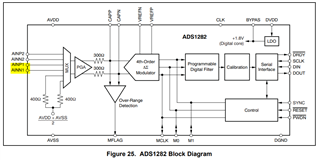The ADS1282's datasheet states that this device can be used with unipolar (0V, 5V) or bipolar (-2.5V, 2.5) analog voltage supplies.
I would like to know if it is possible to use it with an asymmetric (w.r.t. 0V) bipolar configuration: e.g. (-1V, 4V) or (-2V, 3V)). If so, how the output data shall be interpreted?
As far as I understand, the output code will have an offset. This is, for an input voltage of 0V the output code will not be 00000000h but the equivalent of a negative value. Is this correct?
Thanks in advance!
Best regards.



